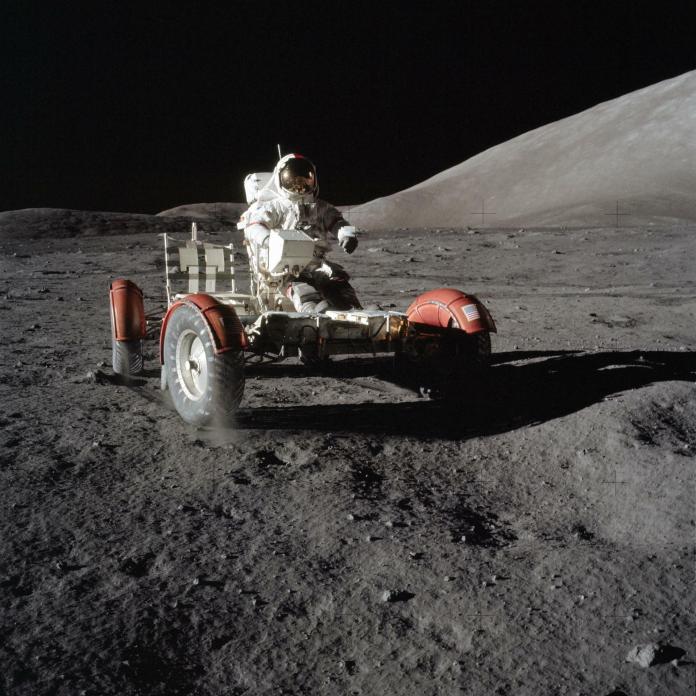
Astronaut Eugene Cernan sits on a barebones Lunar Roving Vehicle during Apollo 17 in 1972. After lowering it from the Lunar Module and unfolding it, astronauts had to raise the seats and install equipment like communications antennae. In this image, the astronauts have not finishing loading equipment onto the LRV. Credit: NASA
“Certainly it was a challenge,” he said. “They had done a lot of work at Marshall Space Flight Center and out in desert testing on rovers testing on rovers. So they had a pretty good idea about the mobility and how you would go about driving.”
Bulky astronaut spacesuits inspired the use of a joystick-like hand controller and control console instead of a more traditional steering wheel and pedals. The open-air design made the rovers both easier to get on and off, and easier to fold and store on the Lunar Module.
The Lunar Roving Vehicle’s control console and the white hand controller beneath it. While the control console gave speed and directional readins and allowed astronauts to adjust power settings, the hand controller handled acceleration, braking, and steering. Credit: Nasa
Over the three missions, astronauts drove the rovers 22.3 miles.
Engineers faced some pretty steep design hurdles. The rovers had to fold up to fit on the Lunar Module. They had to function in low gravity. And dust got absolutely everywhere.
Moon dust soaks up solar radiation, giving it an electrical charge and making it extra clingy. With no wind or water erosion on the moon, the dust has a sharp, glass-like quality. It eats through layers of spacesuit material, gums up mechanisms, and messes with electronics. To cope, fenders kept the LRV’s wheels from kicking up too much dust, dust covers shielded radiators during drives, and brushes were used to sweep away excess dust.
Astronaut footprints and tracks from the LRV are visible on the dusty surface of the moon, pictured here during Apollo 15. Credit: NASA
The engineers had another problem: keeping the electronics on the LRV from freezing and overheating, both during the space journey and on the moon. One ingenious solution was called “barbecue mode.” In transit, the spacecraft rotated like a rotisserie, which distributed and regulated heat.
The three rover models are effectively identical, although wheel fenders on the Apollo 16 and 17 LRVs did take damage, both from astronauts accidentally catching the fender extensions with hammers and popping them off. To stem the extra dust kicking up from the back wheel, Apollo 17 astronaut Eugene Cernan came up with a ragtag solution.
“He came up with a method that was: Take some lunar maps that they had in the Lunar Module, duct tape them together, then take some clamps out of the Lunar Module and clamp on that new fender extension on the road,” Creel said. “And it did help them out.”
A makeshift solution for a broken fender on the back of the Apollo 17 Lunar Roving Vehicle. Astronaut Eugene Cernan accidentally broke the fender with a hammer. Credit: Nasa
The LRVs were NASA’s first rovers used outside Earth, arriving on the moon less than a year after the Soviet space program’s first remote-controlled Lunokhod 1 touched down. Despite the challenges and a couple hiccups, the LRV was a resounding success.
“It was a great feeling to be associated with the development program,” said Otha H. “Skeet” Vaughan Jr. in an email. Vaughan helped develop the environmental design criteria for the Lunar Roving Vehicle — basically, instructions on how to make a buggy that actually works on the moon.
With waned interest in the moon, NASA didn’t land another rover on an extraterrestrial body until Sojourner hit Mars in 1997. The agency’s next lunar rover, VIPER, won’t launch until at least 2023, the same year that the crewed flight around the moon, Artemis 2, is scheduled.
If astronauts stay on the moon for several days, future rovers will need to be able to withstand the moon’s most extreme temperatures. There are also the dust and radiation issues.
“Use past experience,” Creel said as a piece of advice to today’s engineers. “We certainly didn’t know everything we were going to be doing and needed to know about, but had probably 95 percent of it done.”
As astronauts explore the moon in the future, they may come across the original three LRVs. They won’t work anymore, given the harsh environment, but they’ll be sitting there, monuments to a previous era of space exploration.
